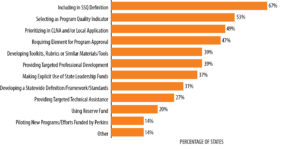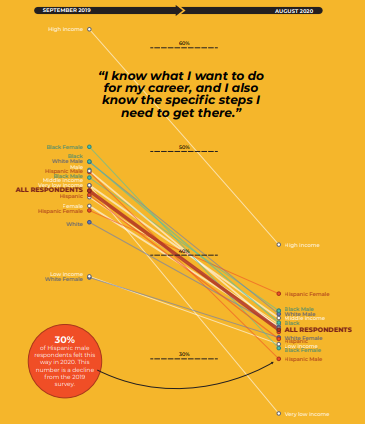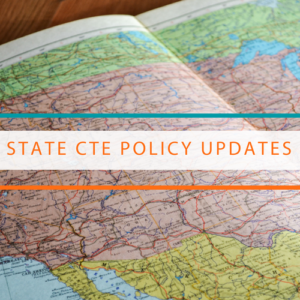![]()
Work-based learning offers learners opportunities to deepen classroom learning, explore future career fields and demonstrate skills in an authentic setting. These experiences are increasingly a priority for states across all career and technical education (CTE) learner levels. Recently, provisions for work-based learning have been greatly expanded by the Strengthening Career Technical Education for the 21st Century Act (Perkins V).
These provisions include the first formal federal definition for “work-based learning,” which allows a multitude of activities to count as a work-based learning experience. Given that this definition of work-based learning is broad, it is important that states consider what constitutes quality work-based learning so that each learner’s experience is meaningful and results in tangible outcomes.
Perkins V also now supports work-based learning through the new secondary program quality indicator. States can choose from three indicator options: work-based learning, recognized postsecondary credentials (credentials of value) and postsecondary credit attainment (dual enrollment and articulation). These are all components of a high-quality CTE program of study, in addition to critical elements like rigorous standards, quality assessments, and alignment to high-skill, high-wage and in-demand career opportunities.
In October 2020, Advance CTE released a report entitled, “The State of Career Technical Education: An Analysis of States’ Perkins V Priorities,” which examines how states have leveraged the development of the Perkins V state plans to expand quality and increase equity within their CTE systems. Advance CTE found that states largely took up the mantle of supporting and expanding work-based learning. Notably:
- Thirty-four states use work-based learning in their size, scope and quality definitions. This definition is used as a litmus test by states to determine Perkins V funding eligibility, among other uses.
- Twenty-four states and the District of Columbia are prioritizing work-based learning as part of their comprehensive local needs assessment process or local application process.
- Twenty-three states and the District of Columbia include work-based learning as a factor when approving new or existing CTE programs.
- Sixteen states are developing definitions, frameworks or related standards to further support the implementation of these opportunities with Perkins resources.
These findings indicate that states are still in the process of building systems and related supports to bring work-based learning to scale.
State Strategies to Advance Work-Based Learning

Key Innovations
- In Delaware, learner participation in a work-based learning experience is a required component of all state-approved CTE programs of study, and the state is funding a statewide work-based learning intermediary. Delaware takes these efforts even further in its Perkins V plan, ensuring close collaboration across state CTE and workforce development systems to provide youths and adults with disabilities the supports they need to complete work-based learning experiences.
- Texas is leveraging Perkins V to expand upon its work-based learning system and opportunities. With Perkins resources, Texas is making extensive use of virtual schools to allow learners to participate in virtual work-based learning experiences. This option is important in communities, especially rural areas, where work-based learning opportunities may be limited. In the short term, the option is even more critical given the impact of the COVID-19 pandemic.
The Work Ahead
Perkins V structures the work-based learning program quality measure around learner participation. As a result, states are not required to comparably structure this measure around completion or attainment. However, it’s important that work-based learning program quality measures are defined robustly and focus on completion of meaningful and rigorous work-based learning experiences that set learners up for success. With over half of states now counting work-based learning within their Perkins V accountability systems, the work ahead is significant yet critical to scaling high-quality and equitable work-based learning experiences.
Christina Koch, Policy Associate
Tom Keily, Senior Policy Analyst, Education Commission on the States


 The “Getting to Know” blog series will feature the work of State CTE Directors, state and federal policies, innovative programs and new initiatives from the Advance CTE staff. Learn more about each one of these topics and the unique contributions to advancing Career Technical Education (CTE) that Advance CTE’s members work on every day.
The “Getting to Know” blog series will feature the work of State CTE Directors, state and federal policies, innovative programs and new initiatives from the Advance CTE staff. Learn more about each one of these topics and the unique contributions to advancing Career Technical Education (CTE) that Advance CTE’s members work on every day.
 As the legislative sessions move forward, states have passed laws to examine and increase work-based learning opportunities for learners.
As the legislative sessions move forward, states have passed laws to examine and increase work-based learning opportunities for learners. The destruction of Hurricane Katrina in 2005 transformed New Orleans into a place where construction is not just a high demand, high-wage career, but an act of service to the community.
The destruction of Hurricane Katrina in 2005 transformed New Orleans into a place where construction is not just a high demand, high-wage career, but an act of service to the community.  Through NSFY, Delaware, Kentucky, Louisiana, Massachusetts, Nevada, Ohio, Oklahoma, Rhode Island, Tennessee and Wisconsin took action to:
Through NSFY, Delaware, Kentucky, Louisiana, Massachusetts, Nevada, Ohio, Oklahoma, Rhode Island, Tennessee and Wisconsin took action to: Some states are exploring how to leverage apprenticeships to award college credit to learners. For instance, the Colorado legislature passed
Some states are exploring how to leverage apprenticeships to award college credit to learners. For instance, the Colorado legislature passed  It is common practice in the private sector to use big data to improve efficiency, strengthen product quality and better target services to customers. Can data also be used to improve the quality of public education, specifically Career Technical Education (CTE)?
It is common practice in the private sector to use big data to improve efficiency, strengthen product quality and better target services to customers. Can data also be used to improve the quality of public education, specifically Career Technical Education (CTE)?